ASEAN Open Skies: Analysis of Economic and Social Impacts Report
VerifiedAdded on 2021/04/21
|7
|1424
|50
Report
AI Summary
This report provides an overview of the ASEAN Open Skies policy, examining its historical context, development, and the outcomes for the involved countries. It details the policy's effects on airline competition, local economies, and consumers, while also identifying the problems faced by the member states. The report analyzes the impact on economic growth, tourism, and the challenges of infrastructural inadequacies. It emphasizes the benefits for consumers through increased airline choices and competitive pricing. The analysis also addresses issues like government tax policies, the lack of human resources, and political unrest within the ASEAN region. References from various academic sources are included to support the findings.
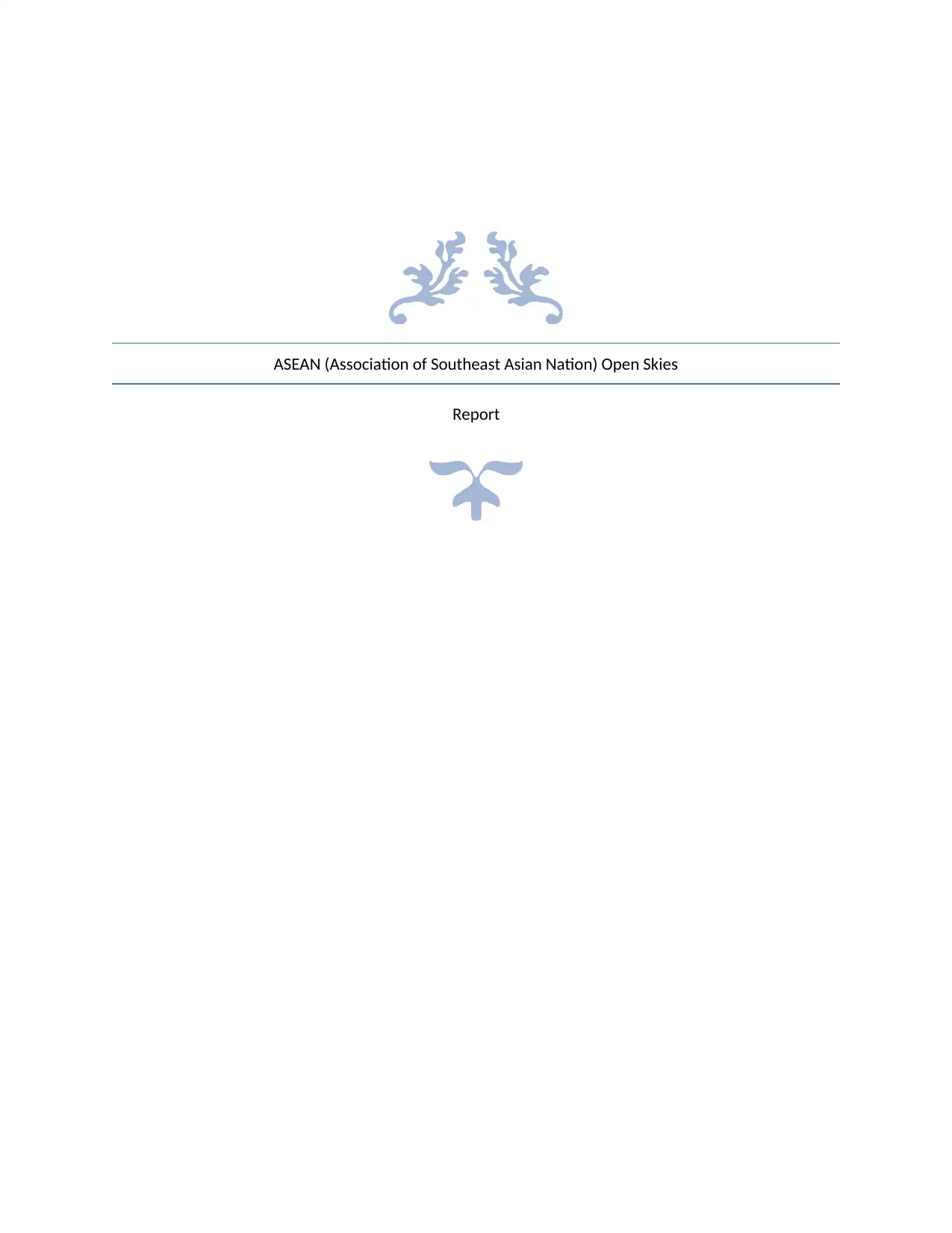
ASEAN (Association of Southeast Asian Nation) Open Skies
Report
Report
Paraphrase This Document
Need a fresh take? Get an instant paraphrase of this document with our AI Paraphraser
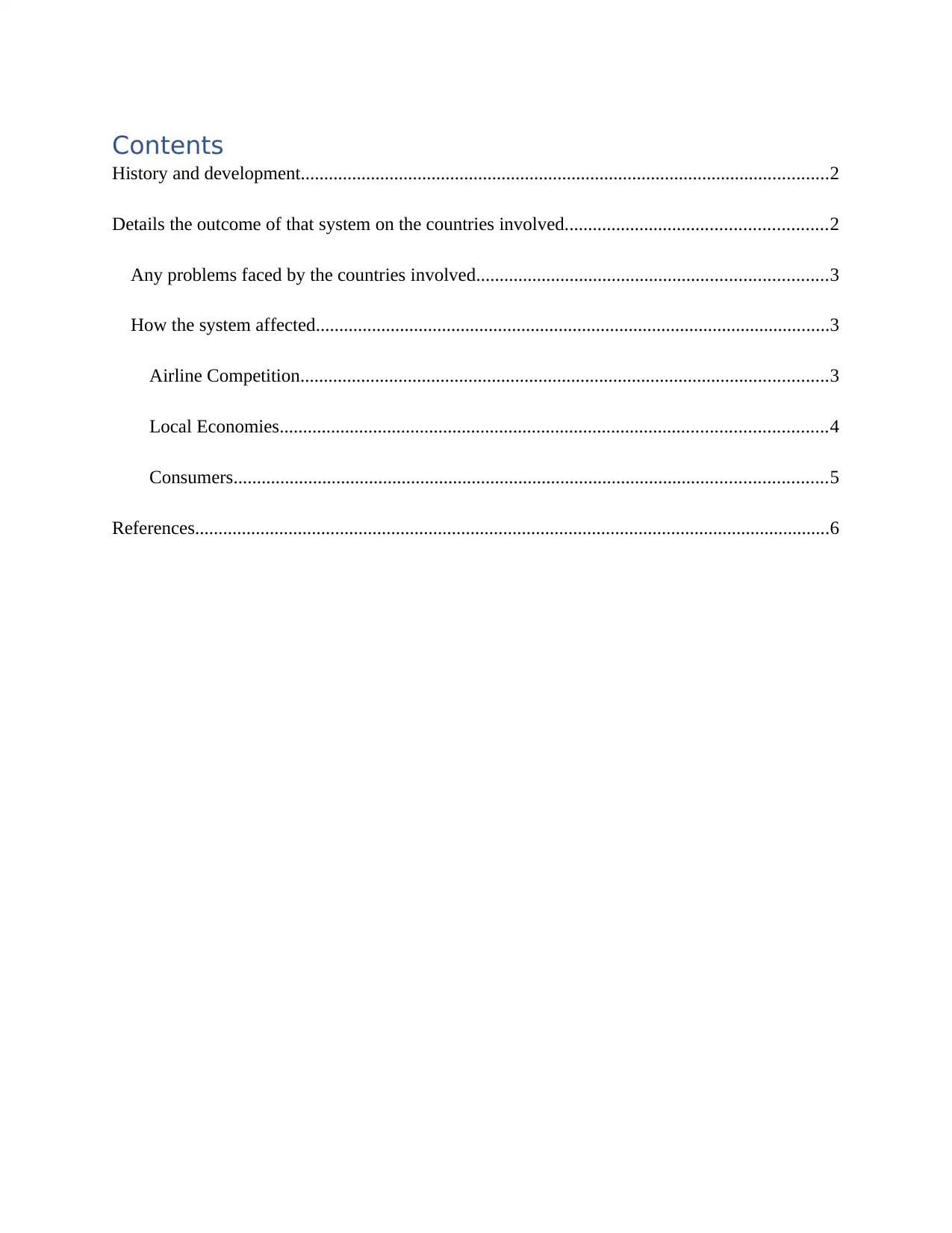
Contents
History and development.................................................................................................................2
Details the outcome of that system on the countries involved........................................................2
Any problems faced by the countries involved...........................................................................3
How the system affected..............................................................................................................3
Airline Competition.................................................................................................................3
Local Economies.....................................................................................................................4
Consumers...............................................................................................................................5
References........................................................................................................................................6
History and development.................................................................................................................2
Details the outcome of that system on the countries involved........................................................2
Any problems faced by the countries involved...........................................................................3
How the system affected..............................................................................................................3
Airline Competition.................................................................................................................3
Local Economies.....................................................................................................................4
Consumers...............................................................................................................................5
References........................................................................................................................................6
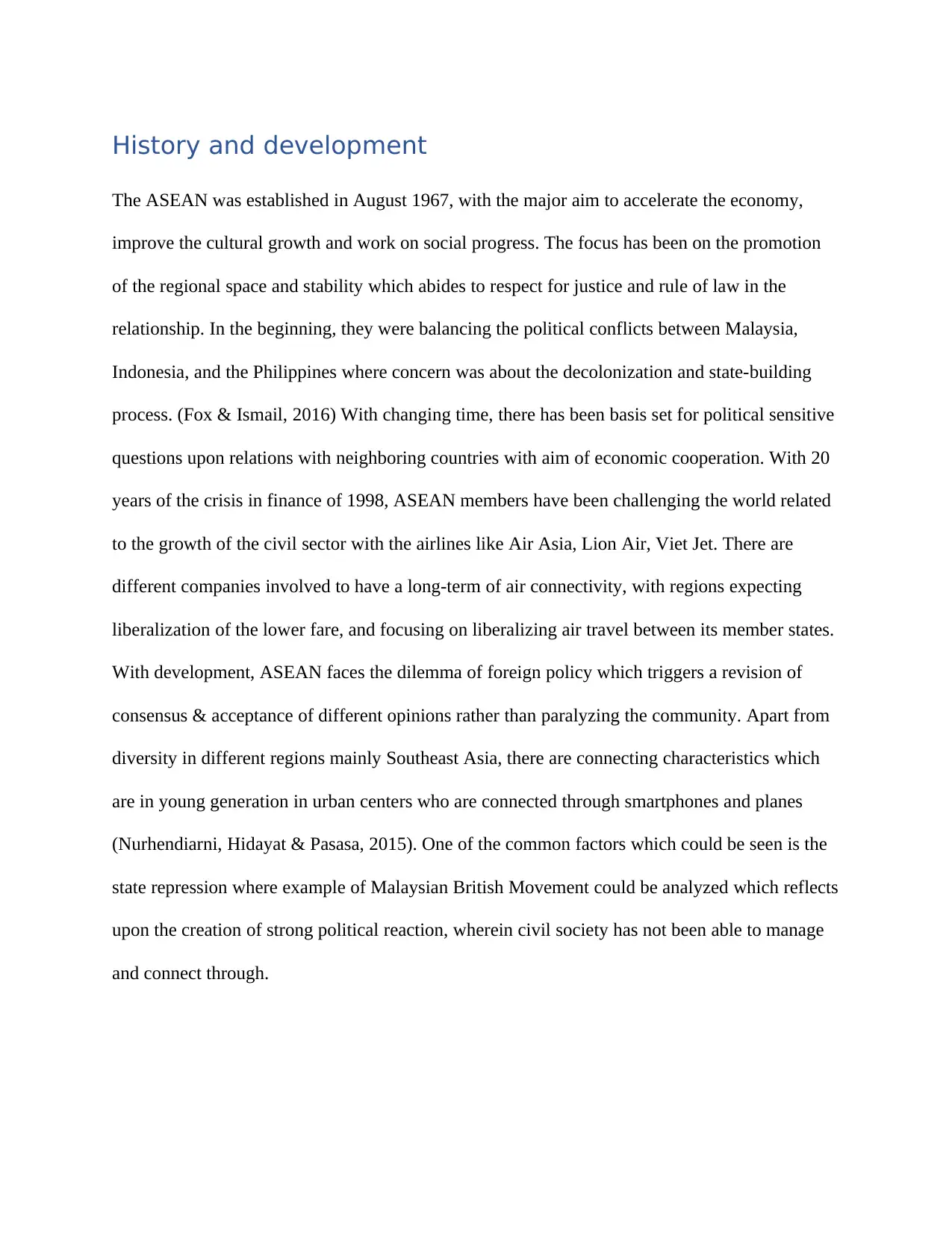
History and development
The ASEAN was established in August 1967, with the major aim to accelerate the economy,
improve the cultural growth and work on social progress. The focus has been on the promotion
of the regional space and stability which abides to respect for justice and rule of law in the
relationship. In the beginning, they were balancing the political conflicts between Malaysia,
Indonesia, and the Philippines where concern was about the decolonization and state-building
process. (Fox & Ismail, 2016) With changing time, there has been basis set for political sensitive
questions upon relations with neighboring countries with aim of economic cooperation. With 20
years of the crisis in finance of 1998, ASEAN members have been challenging the world related
to the growth of the civil sector with the airlines like Air Asia, Lion Air, Viet Jet. There are
different companies involved to have a long-term of air connectivity, with regions expecting
liberalization of the lower fare, and focusing on liberalizing air travel between its member states.
With development, ASEAN faces the dilemma of foreign policy which triggers a revision of
consensus & acceptance of different opinions rather than paralyzing the community. Apart from
diversity in different regions mainly Southeast Asia, there are connecting characteristics which
are in young generation in urban centers who are connected through smartphones and planes
(Nurhendiarni, Hidayat & Pasasa, 2015). One of the common factors which could be seen is the
state repression where example of Malaysian British Movement could be analyzed which reflects
upon the creation of strong political reaction, wherein civil society has not been able to manage
and connect through.
The ASEAN was established in August 1967, with the major aim to accelerate the economy,
improve the cultural growth and work on social progress. The focus has been on the promotion
of the regional space and stability which abides to respect for justice and rule of law in the
relationship. In the beginning, they were balancing the political conflicts between Malaysia,
Indonesia, and the Philippines where concern was about the decolonization and state-building
process. (Fox & Ismail, 2016) With changing time, there has been basis set for political sensitive
questions upon relations with neighboring countries with aim of economic cooperation. With 20
years of the crisis in finance of 1998, ASEAN members have been challenging the world related
to the growth of the civil sector with the airlines like Air Asia, Lion Air, Viet Jet. There are
different companies involved to have a long-term of air connectivity, with regions expecting
liberalization of the lower fare, and focusing on liberalizing air travel between its member states.
With development, ASEAN faces the dilemma of foreign policy which triggers a revision of
consensus & acceptance of different opinions rather than paralyzing the community. Apart from
diversity in different regions mainly Southeast Asia, there are connecting characteristics which
are in young generation in urban centers who are connected through smartphones and planes
(Nurhendiarni, Hidayat & Pasasa, 2015). One of the common factors which could be seen is the
state repression where example of Malaysian British Movement could be analyzed which reflects
upon the creation of strong political reaction, wherein civil society has not been able to manage
and connect through.
⊘ This is a preview!⊘
Do you want full access?
Subscribe today to unlock all pages.

Trusted by 1+ million students worldwide
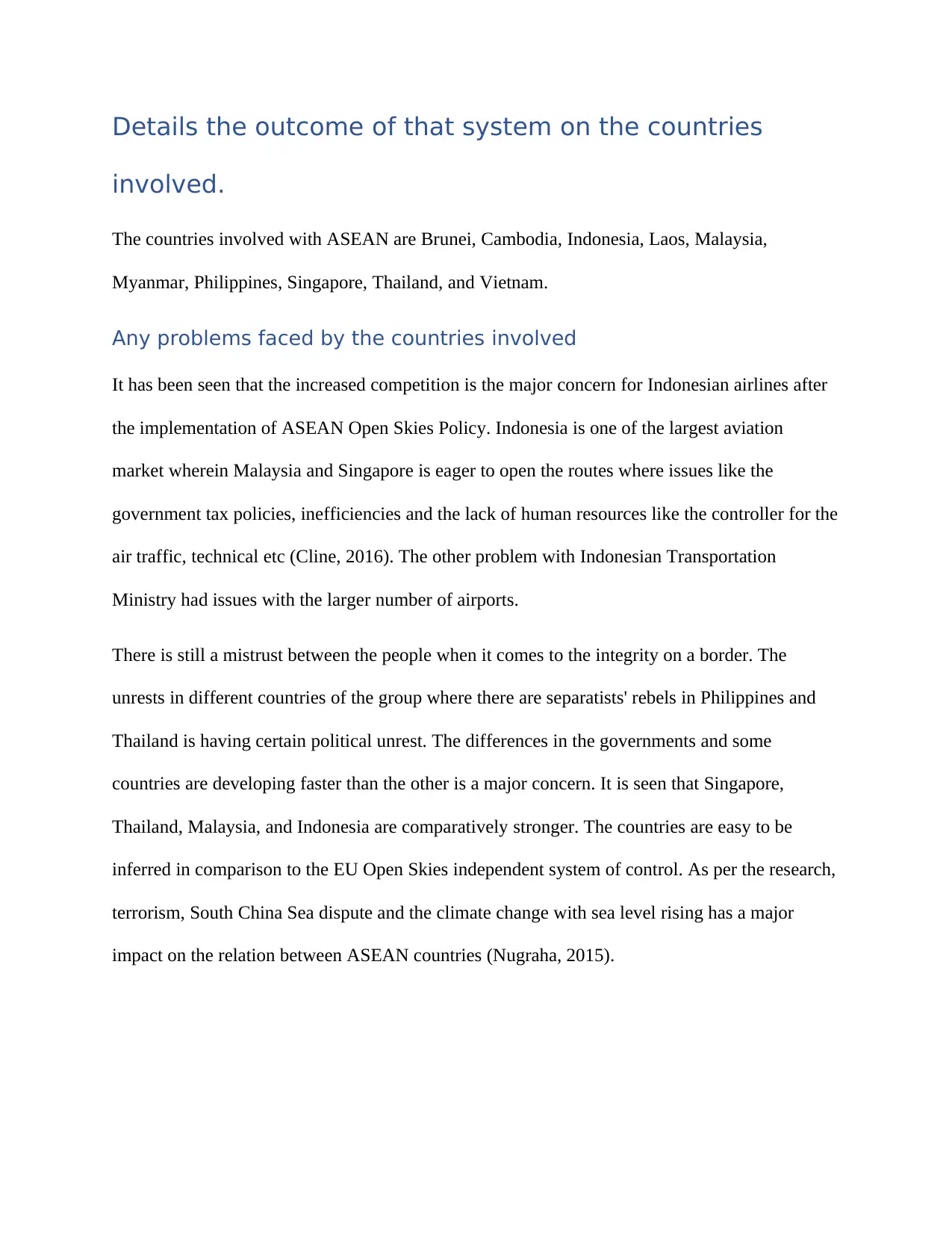
Details the outcome of that system on the countries
involved.
The countries involved with ASEAN are Brunei, Cambodia, Indonesia, Laos, Malaysia,
Myanmar, Philippines, Singapore, Thailand, and Vietnam.
Any problems faced by the countries involved
It has been seen that the increased competition is the major concern for Indonesian airlines after
the implementation of ASEAN Open Skies Policy. Indonesia is one of the largest aviation
market wherein Malaysia and Singapore is eager to open the routes where issues like the
government tax policies, inefficiencies and the lack of human resources like the controller for the
air traffic, technical etc (Cline, 2016). The other problem with Indonesian Transportation
Ministry had issues with the larger number of airports.
There is still a mistrust between the people when it comes to the integrity on a border. The
unrests in different countries of the group where there are separatists' rebels in Philippines and
Thailand is having certain political unrest. The differences in the governments and some
countries are developing faster than the other is a major concern. It is seen that Singapore,
Thailand, Malaysia, and Indonesia are comparatively stronger. The countries are easy to be
inferred in comparison to the EU Open Skies independent system of control. As per the research,
terrorism, South China Sea dispute and the climate change with sea level rising has a major
impact on the relation between ASEAN countries (Nugraha, 2015).
involved.
The countries involved with ASEAN are Brunei, Cambodia, Indonesia, Laos, Malaysia,
Myanmar, Philippines, Singapore, Thailand, and Vietnam.
Any problems faced by the countries involved
It has been seen that the increased competition is the major concern for Indonesian airlines after
the implementation of ASEAN Open Skies Policy. Indonesia is one of the largest aviation
market wherein Malaysia and Singapore is eager to open the routes where issues like the
government tax policies, inefficiencies and the lack of human resources like the controller for the
air traffic, technical etc (Cline, 2016). The other problem with Indonesian Transportation
Ministry had issues with the larger number of airports.
There is still a mistrust between the people when it comes to the integrity on a border. The
unrests in different countries of the group where there are separatists' rebels in Philippines and
Thailand is having certain political unrest. The differences in the governments and some
countries are developing faster than the other is a major concern. It is seen that Singapore,
Thailand, Malaysia, and Indonesia are comparatively stronger. The countries are easy to be
inferred in comparison to the EU Open Skies independent system of control. As per the research,
terrorism, South China Sea dispute and the climate change with sea level rising has a major
impact on the relation between ASEAN countries (Nugraha, 2015).
Paraphrase This Document
Need a fresh take? Get an instant paraphrase of this document with our AI Paraphraser
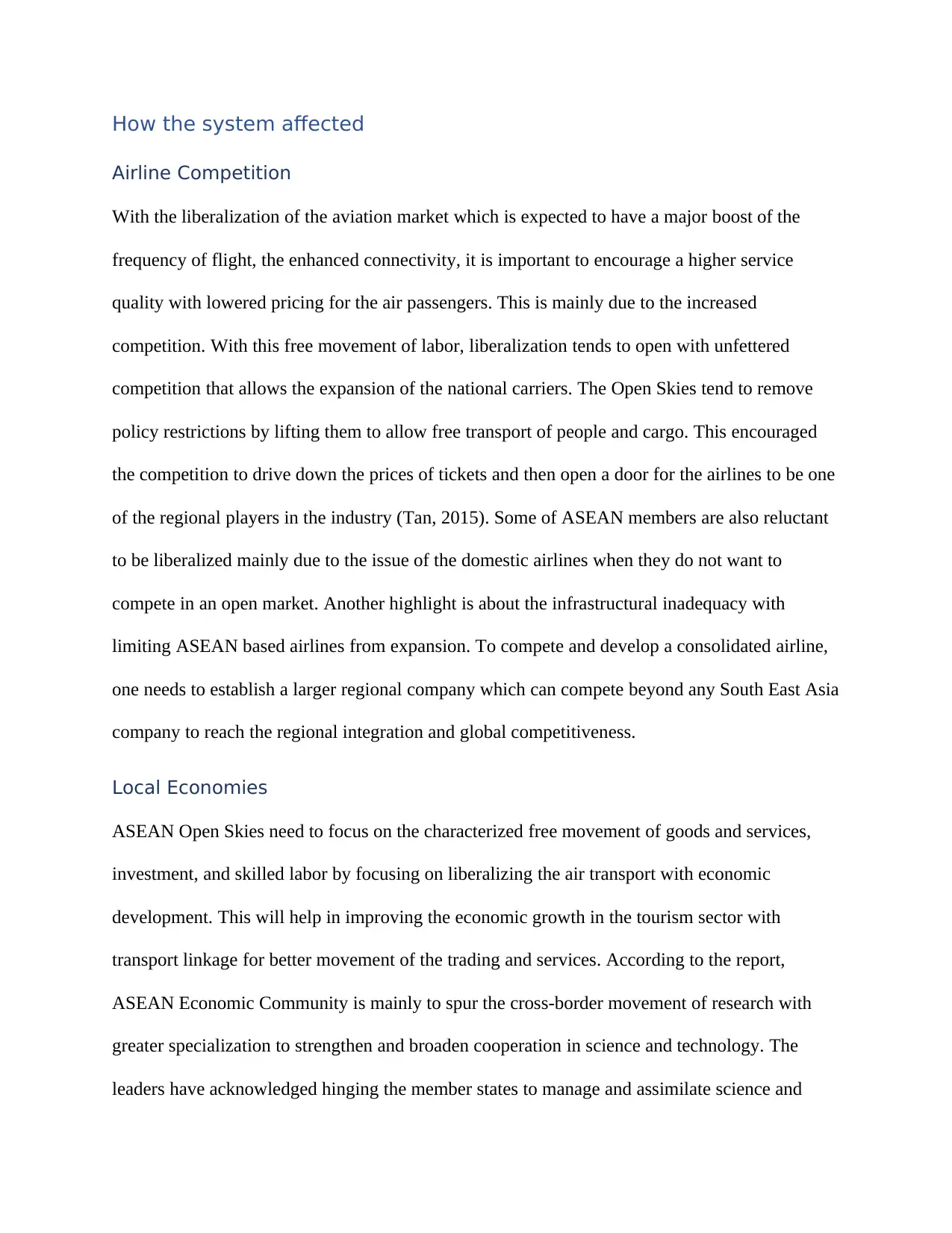
How the system affected
Airline Competition
With the liberalization of the aviation market which is expected to have a major boost of the
frequency of flight, the enhanced connectivity, it is important to encourage a higher service
quality with lowered pricing for the air passengers. This is mainly due to the increased
competition. With this free movement of labor, liberalization tends to open with unfettered
competition that allows the expansion of the national carriers. The Open Skies tend to remove
policy restrictions by lifting them to allow free transport of people and cargo. This encouraged
the competition to drive down the prices of tickets and then open a door for the airlines to be one
of the regional players in the industry (Tan, 2015). Some of ASEAN members are also reluctant
to be liberalized mainly due to the issue of the domestic airlines when they do not want to
compete in an open market. Another highlight is about the infrastructural inadequacy with
limiting ASEAN based airlines from expansion. To compete and develop a consolidated airline,
one needs to establish a larger regional company which can compete beyond any South East Asia
company to reach the regional integration and global competitiveness.
Local Economies
ASEAN Open Skies need to focus on the characterized free movement of goods and services,
investment, and skilled labor by focusing on liberalizing the air transport with economic
development. This will help in improving the economic growth in the tourism sector with
transport linkage for better movement of the trading and services. According to the report,
ASEAN Economic Community is mainly to spur the cross-border movement of research with
greater specialization to strengthen and broaden cooperation in science and technology. The
leaders have acknowledged hinging the member states to manage and assimilate science and
Airline Competition
With the liberalization of the aviation market which is expected to have a major boost of the
frequency of flight, the enhanced connectivity, it is important to encourage a higher service
quality with lowered pricing for the air passengers. This is mainly due to the increased
competition. With this free movement of labor, liberalization tends to open with unfettered
competition that allows the expansion of the national carriers. The Open Skies tend to remove
policy restrictions by lifting them to allow free transport of people and cargo. This encouraged
the competition to drive down the prices of tickets and then open a door for the airlines to be one
of the regional players in the industry (Tan, 2015). Some of ASEAN members are also reluctant
to be liberalized mainly due to the issue of the domestic airlines when they do not want to
compete in an open market. Another highlight is about the infrastructural inadequacy with
limiting ASEAN based airlines from expansion. To compete and develop a consolidated airline,
one needs to establish a larger regional company which can compete beyond any South East Asia
company to reach the regional integration and global competitiveness.
Local Economies
ASEAN Open Skies need to focus on the characterized free movement of goods and services,
investment, and skilled labor by focusing on liberalizing the air transport with economic
development. This will help in improving the economic growth in the tourism sector with
transport linkage for better movement of the trading and services. According to the report,
ASEAN Economic Community is mainly to spur the cross-border movement of research with
greater specialization to strengthen and broaden cooperation in science and technology. The
leaders have acknowledged hinging the member states to manage and assimilate science and
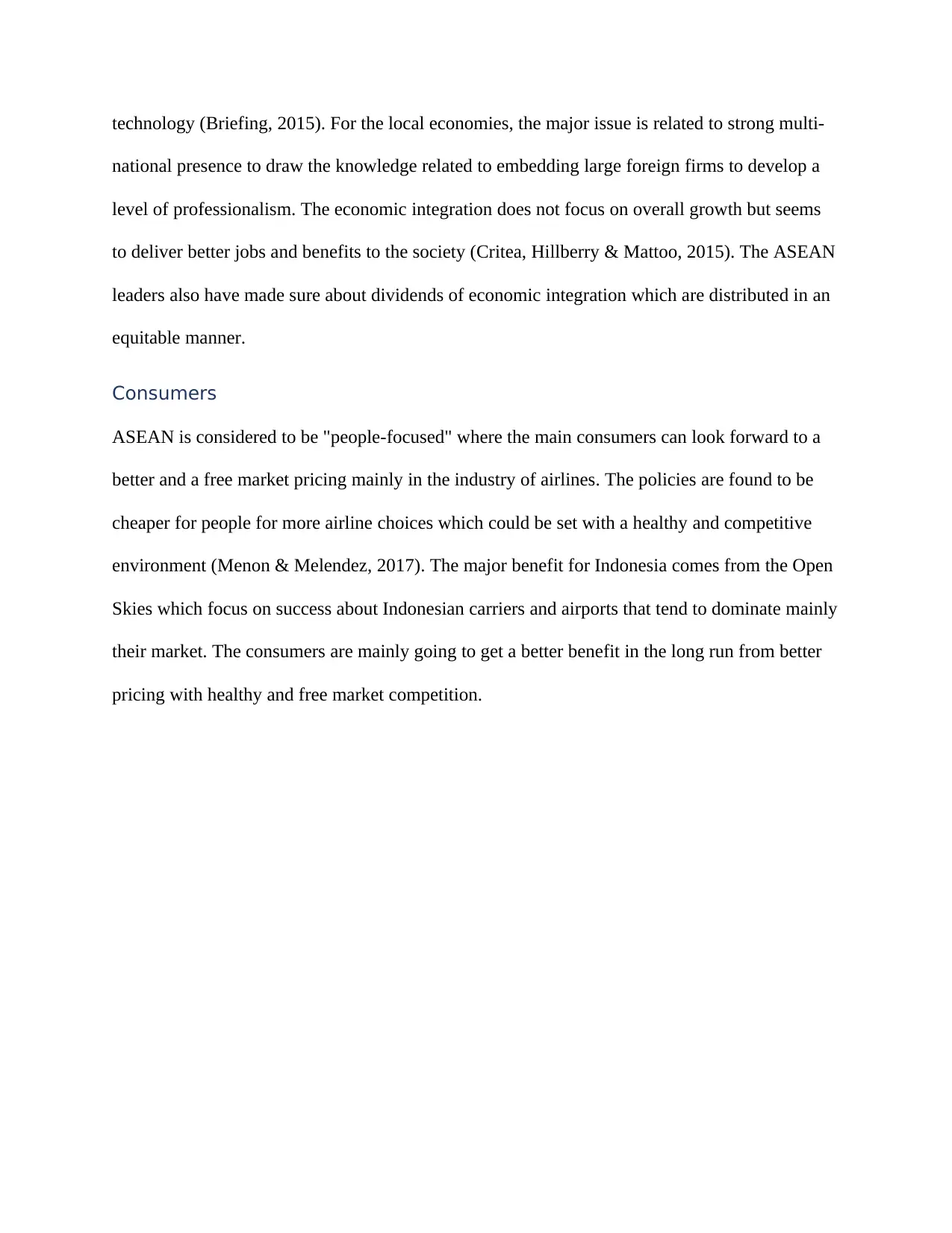
technology (Briefing, 2015). For the local economies, the major issue is related to strong multi-
national presence to draw the knowledge related to embedding large foreign firms to develop a
level of professionalism. The economic integration does not focus on overall growth but seems
to deliver better jobs and benefits to the society (Critea, Hillberry & Mattoo, 2015). The ASEAN
leaders also have made sure about dividends of economic integration which are distributed in an
equitable manner.
Consumers
ASEAN is considered to be "people-focused" where the main consumers can look forward to a
better and a free market pricing mainly in the industry of airlines. The policies are found to be
cheaper for people for more airline choices which could be set with a healthy and competitive
environment (Menon & Melendez, 2017). The major benefit for Indonesia comes from the Open
Skies which focus on success about Indonesian carriers and airports that tend to dominate mainly
their market. The consumers are mainly going to get a better benefit in the long run from better
pricing with healthy and free market competition.
national presence to draw the knowledge related to embedding large foreign firms to develop a
level of professionalism. The economic integration does not focus on overall growth but seems
to deliver better jobs and benefits to the society (Critea, Hillberry & Mattoo, 2015). The ASEAN
leaders also have made sure about dividends of economic integration which are distributed in an
equitable manner.
Consumers
ASEAN is considered to be "people-focused" where the main consumers can look forward to a
better and a free market pricing mainly in the industry of airlines. The policies are found to be
cheaper for people for more airline choices which could be set with a healthy and competitive
environment (Menon & Melendez, 2017). The major benefit for Indonesia comes from the Open
Skies which focus on success about Indonesian carriers and airports that tend to dominate mainly
their market. The consumers are mainly going to get a better benefit in the long run from better
pricing with healthy and free market competition.
⊘ This is a preview!⊘
Do you want full access?
Subscribe today to unlock all pages.

Trusted by 1+ million students worldwide
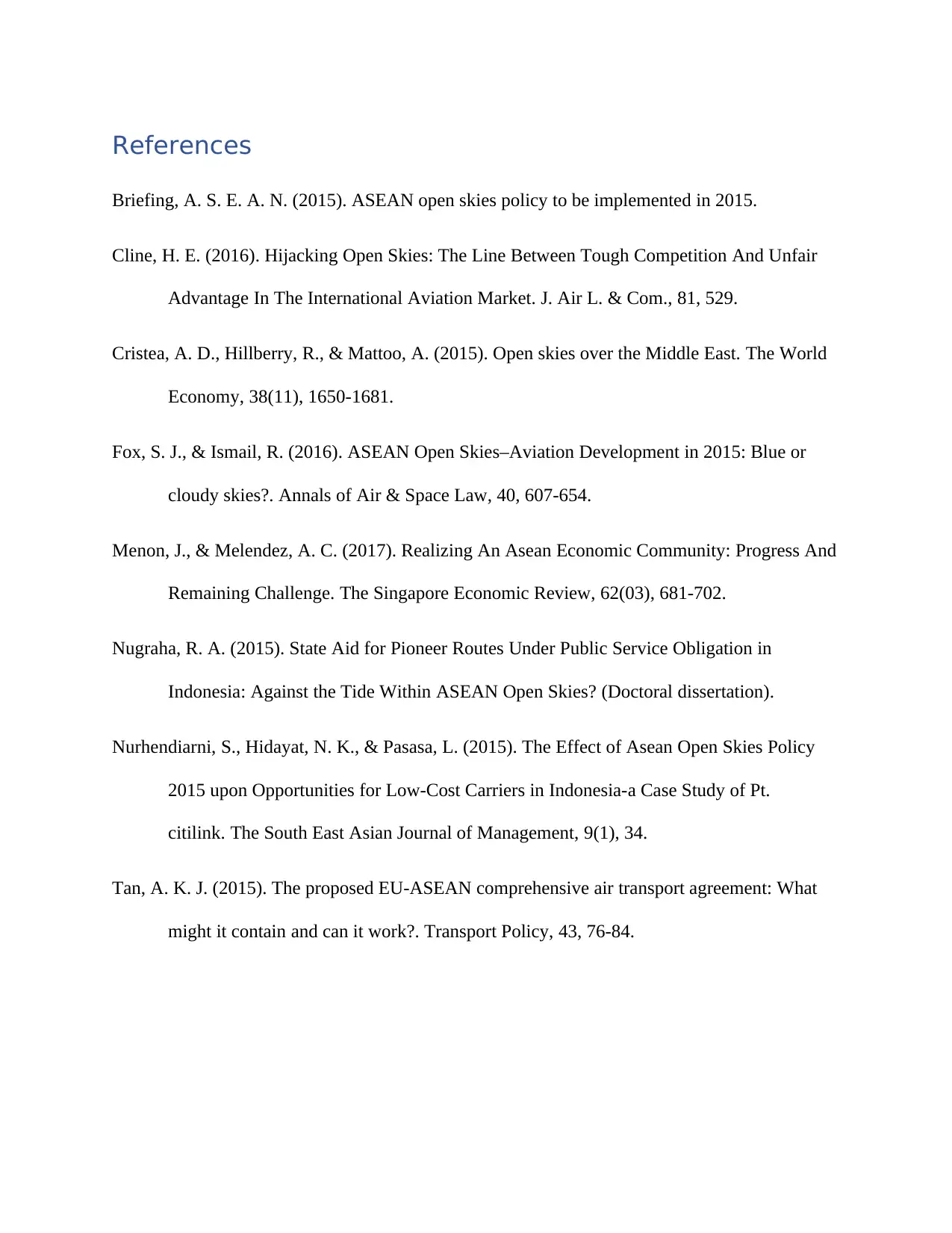
References
Briefing, A. S. E. A. N. (2015). ASEAN open skies policy to be implemented in 2015.
Cline, H. E. (2016). Hijacking Open Skies: The Line Between Tough Competition And Unfair
Advantage In The International Aviation Market. J. Air L. & Com., 81, 529.
Cristea, A. D., Hillberry, R., & Mattoo, A. (2015). Open skies over the Middle East. The World
Economy, 38(11), 1650-1681.
Fox, S. J., & Ismail, R. (2016). ASEAN Open Skies–Aviation Development in 2015: Blue or
cloudy skies?. Annals of Air & Space Law, 40, 607-654.
Menon, J., & Melendez, A. C. (2017). Realizing An Asean Economic Community: Progress And
Remaining Challenge. The Singapore Economic Review, 62(03), 681-702.
Nugraha, R. A. (2015). State Aid for Pioneer Routes Under Public Service Obligation in
Indonesia: Against the Tide Within ASEAN Open Skies? (Doctoral dissertation).
Nurhendiarni, S., Hidayat, N. K., & Pasasa, L. (2015). The Effect of Asean Open Skies Policy
2015 upon Opportunities for Low-Cost Carriers in Indonesia-a Case Study of Pt.
citilink. The South East Asian Journal of Management, 9(1), 34.
Tan, A. K. J. (2015). The proposed EU-ASEAN comprehensive air transport agreement: What
might it contain and can it work?. Transport Policy, 43, 76-84.
Briefing, A. S. E. A. N. (2015). ASEAN open skies policy to be implemented in 2015.
Cline, H. E. (2016). Hijacking Open Skies: The Line Between Tough Competition And Unfair
Advantage In The International Aviation Market. J. Air L. & Com., 81, 529.
Cristea, A. D., Hillberry, R., & Mattoo, A. (2015). Open skies over the Middle East. The World
Economy, 38(11), 1650-1681.
Fox, S. J., & Ismail, R. (2016). ASEAN Open Skies–Aviation Development in 2015: Blue or
cloudy skies?. Annals of Air & Space Law, 40, 607-654.
Menon, J., & Melendez, A. C. (2017). Realizing An Asean Economic Community: Progress And
Remaining Challenge. The Singapore Economic Review, 62(03), 681-702.
Nugraha, R. A. (2015). State Aid for Pioneer Routes Under Public Service Obligation in
Indonesia: Against the Tide Within ASEAN Open Skies? (Doctoral dissertation).
Nurhendiarni, S., Hidayat, N. K., & Pasasa, L. (2015). The Effect of Asean Open Skies Policy
2015 upon Opportunities for Low-Cost Carriers in Indonesia-a Case Study of Pt.
citilink. The South East Asian Journal of Management, 9(1), 34.
Tan, A. K. J. (2015). The proposed EU-ASEAN comprehensive air transport agreement: What
might it contain and can it work?. Transport Policy, 43, 76-84.
1 out of 7
Related Documents
Your All-in-One AI-Powered Toolkit for Academic Success.
+13062052269
info@desklib.com
Available 24*7 on WhatsApp / Email
![[object Object]](/_next/static/media/star-bottom.7253800d.svg)
Unlock your academic potential
Copyright © 2020–2025 A2Z Services. All Rights Reserved. Developed and managed by ZUCOL.





